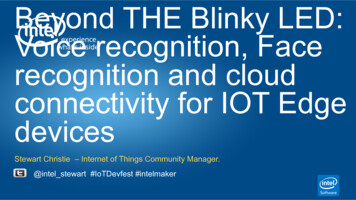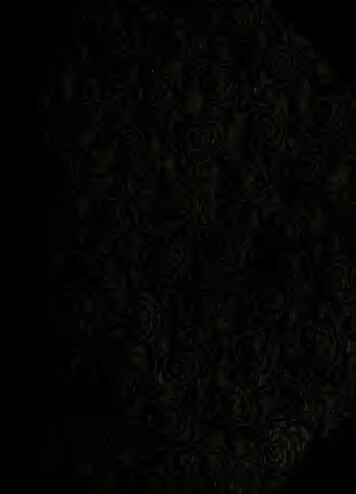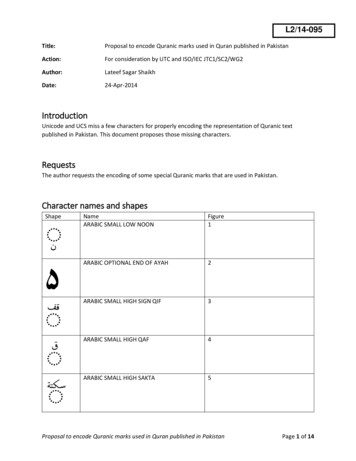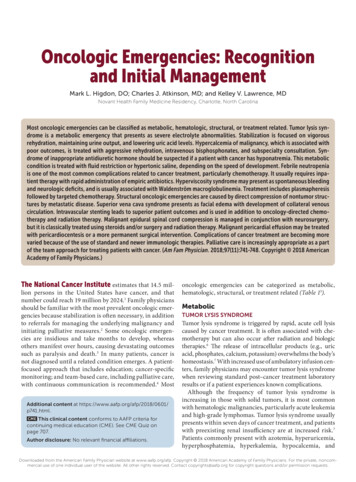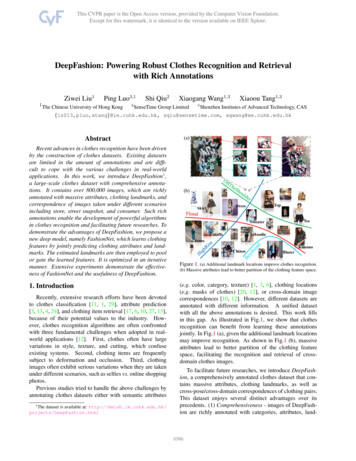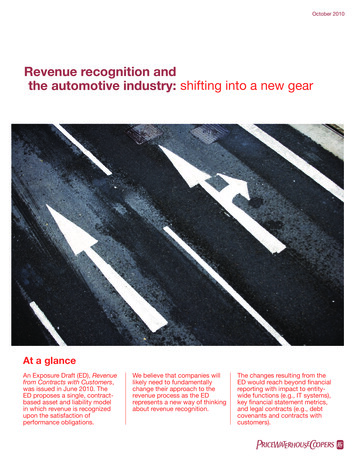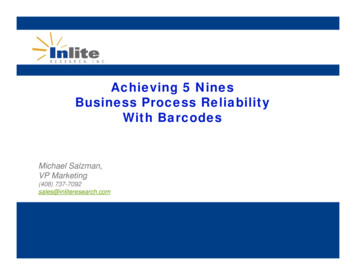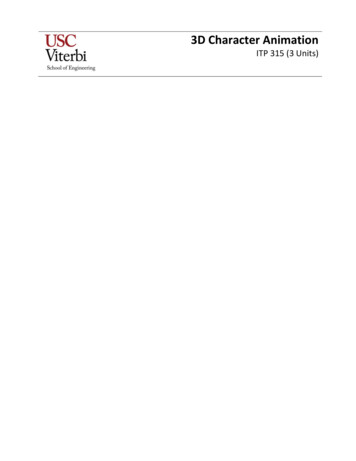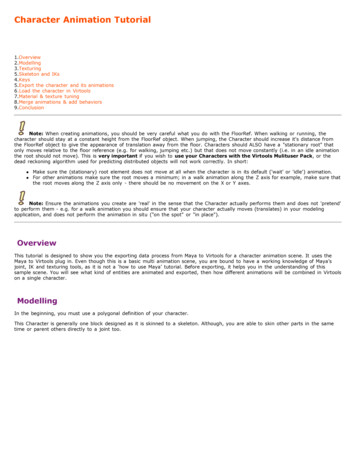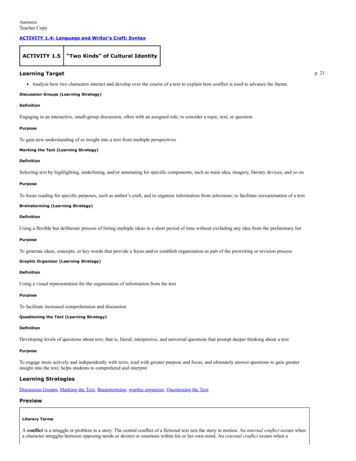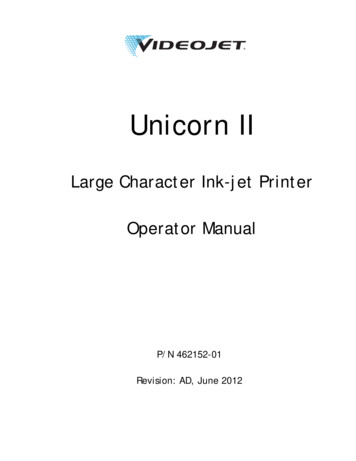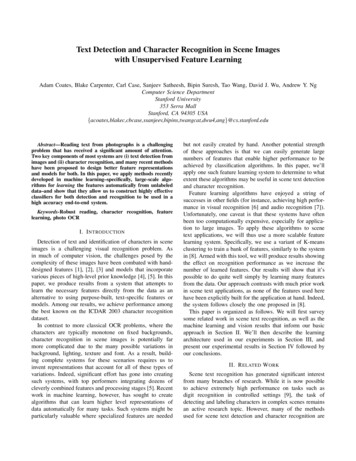
Transcription
Text Detection and Character Recognition in Scene Imageswith Unsupervised Feature LearningAdam Coates, Blake Carpenter, Carl Case, Sanjeev Satheesh, Bipin Suresh, Tao Wang, David J. Wu, Andrew Y. NgComputer Science DepartmentStanford University353 Serra MallStanford, CA 94305 ,dwu4,ang}@cs.stanford.eduAbstract—Reading text from photographs is a challengingproblem that has received a significant amount of attention.Two key components of most systems are (i) text detection fromimages and (ii) character recognition, and many recent methodshave been proposed to design better feature representationsand models for both. In this paper, we apply methods recentlydeveloped in machine learning–specifically, large-scale algorithms for learning the features automatically from unlabeleddata–and show that they allow us to construct highly effectiveclassifiers for both detection and recognition to be used in ahigh accuracy end-to-end system.Keywords-Robust reading, character recognition, featurelearning, photo OCRI. I NTRODUCTIONDetection of text and identification of characters in sceneimages is a challenging visual recognition problem. Asin much of computer vision, the challenges posed by thecomplexity of these images have been combated with handdesigned features [1], [2], [3] and models that incorporatevarious pieces of high-level prior knowledge [4], [5]. In thispaper, we produce results from a system that attempts tolearn the necessary features directly from the data as analternative to using purpose-built, text-specific features ormodels. Among our results, we achieve performance amongthe best known on the ICDAR 2003 character recognitiondataset.In contrast to more classical OCR problems, where thecharacters are typically monotone on fixed backgrounds,character recognition in scene images is potentially farmore complicated due to the many possible variations inbackground, lighting, texture and font. As a result, building complete systems for these scenarios requires us toinvent representations that account for all of these types ofvariations. Indeed, significant effort has gone into creatingsuch systems, with top performers integrating dozens ofcleverly combined features and processing stages [5]. Recentwork in machine learning, however, has sought to createalgorithms that can learn higher level representations ofdata automatically for many tasks. Such systems might beparticularly valuable where specialized features are neededbut not easily created by hand. Another potential strengthof these approaches is that we can easily generate largenumbers of features that enable higher performance to beachieved by classification algorithms. In this paper, we’llapply one such feature learning system to determine to whatextent these algorithms may be useful in scene text detectionand character recognition.Feature learning algorithms have enjoyed a string ofsuccesses in other fields (for instance, achieving high performance in visual recognition [6] and audio recognition [7]).Unfortunately, one caveat is that these systems have oftenbeen too computationally expensive, especially for application to large images. To apply these algorithms to scenetext applications, we will thus use a more scalable featurelearning system. Specifically, we use a variant of K-meansclustering to train a bank of features, similarly to the systemin [8]. Armed with this tool, we will produce results showingthe effect on recognition performance as we increase thenumber of learned features. Our results will show that it’spossible to do quite well simply by learning many featuresfrom the data. Our approach contrasts with much prior workin scene text applications, as none of the features used herehave been explicitly built for the application at hand. Indeed,the system follows closely the one proposed in [8].This paper is organized as follows. We will first surveysome related work in scene text recognition, as well as themachine learning and vision results that inform our basicapproach in Section II. We’ll then describe the learningarchitecture used in our experiments in Section III, andpresent our experimental results in Section IV followed byour conclusions.II. R ELATED W ORKScene text recognition has generated significant interestfrom many branches of research. While it is now possibleto achieve extremely high performance on tasks such asdigit recognition in controlled settings [9], the task ofdetecting and labeling characters in complex scenes remainsan active research topic. However, many of the methodsused for scene text detection and character recognition are
predicated on cleverly engineered systems specific to thenew task. For text detection, for instance, solutions haveranged from simple off-the-shelf classifiers trained on handcoded features [10] to multi-stage pipelines combining manydifferent algorithms [11], [5]. Common features includeedge features, texture descriptors, and shape contexts [1].Meanwhile, various flavors of probabilistic model have alsobeen applied [4], [12], [13], folding many forms of priorknowledge into the detection and recognition system.On the other hand, some systems with highly flexiblelearning schemes attempt to learn all necessary informationfrom labeled data with minimal prior knowledge. For instance, multi-layered neural network architectures have beenapplied to character recognition and are competitive withother leading methods [14]. This mirrors the success of suchapproaches in more traditional document and hand-writtentext recognition systems [15]. Indeed, the method used inour system is related to convolutional neural networks. Theprimary difference is that the training method used hereis unsupervised, and uses a much more scalable trainingalgorithm that can rapidly train many features.Feature learning methods in general are currently thefocus of much research, particularly applied to computervision problems. As a result, a wide variety of algorithmsare now available to learn features from unlabeled data [16],[17], [18], [19], [20]. Many results obtained with featurelearning systems have also shown that higher performancein recognition tasks could be achieved through larger scalerepresentations, such as could be generated by a scalablefeature learning system. For instance, Van Gemert et al. [21]showed that performance can grow with larger numbers oflow-level features, and Li et al. [22] have provided evidenceof a similar phenomenon for high-level features like objectsand parts. In this work, we focus on training low-levelfeatures, but more sophisticated feature learning methodsare capable of learning higher level constructs that might beeven more effective [23], [7], [17], [6].III. L EARNING A RCHITECTUREWe now describe the architecture used to learn the featurerepresentations and train the classifiers used for our detectionand character recognition systems. The basic setup is closelyrelated to a convolutional neural network [15], but due to itstraining method can be used to rapidly construct extremelylarge sets of features with minimal tuning.Our system proceeds in several stages:1) Apply an unsupervised feature learning algorithm to aset of image patches harvested from the training datato learn a bank of image features.2) Evaluate the features convolutionally over the trainingimages. Reduce the number of features using spatialpooling [15].3) Train a linear classifier for either text detection orcharacter recognition.We will now describe each of these stages in more detail.A. Feature learningThe key component of our system is the application ofan unsupervised learning algorithm to generate the featuresused for classification. Many choices of unsupervised learning algorithm are available for this purpose, such as autoencoders [19], RBMs [16], and sparse coding [24]. Here,however, we use a variant of K-means clustering that hasbeen shown to yield results comparable to other methodswhile also being much simpler and faster.Like many feature learning schemes, our system worksby applying a common recipe:1) Collect a set of small image patches, x̃(i) from trainingdata. In our case, we use 8x8 grayscale1 patches, sox̃(i) R64 .2) Apply simple statistical pre-processing (e.g., whitening) to the patches of the input to yield a new datasetx(i) .3) Run an unsupervised learning algorithm on the x(i) tobuild a mapping from input patches to a feature vector,z (i) f (x(i) ).The particular system we employ is similar to the onepresented in [8]. First, given a set of training images, weextract a set of m 8-by-8 pixel patches to yield vectors ofpixels x̃(i) R64 , i {1, . . . , m}. Each vector is brightnessand contrast normalized.2 We then whiten the x̃(i) usingZCA3 whitening [25] to yield x(i) . Given this whitened bankof input vectors, we are now ready to learn a set of featuresthat can be evaluated on such patches.For the unsupervised learning stage, we use a variantof K-means clustering. K-means can be modified so thatit yields a dictionary D R64 d of normalized basisvectors. Specifically, instead of learning “centroids” basedon Euclidean distance, we learn a set of normalized vectorsD(j) , j {1, . . . , d} to form the columns of D, using innerproducts as the similarity metric. That is, we solveXmin Ds(i) x(i) 2(1)D,s(i)i(i)s.t. s 1 s(i) , i D(j) 2 1, j(2)(3)where x(i) are the input examples and s(i) are the corresponding “one hot” encodings4 of the examples. Like Kmeans, the optimization is done by alternating minimizationover D and the s(i) . Here, the optimal solution for s(i) given1 All of our experiments use grayscale images, though the methods hereare equally applicable to color patches.2 We subtract out the mean and divide by the standard deviation of allthe pixel values.3 ZCA whitening is like PCA whitening, except that it rotates the databack to the same axes as the original input.4 The constraint s(i) s(i) (i) may have only 1 means that s1non-zero value, though its magnitude is unconstrained.
Figure 1. A small subset of the dictionary elements learned from grayscale,8-by-8 pixel image patches extracted from the ICDAR 2003 dataset.(i)D is to set sk D(k) x(i) for k arg maxj D(j) x(i) ,(i)and set sj 0 for all other j 6 k. Then, holding all s(i)fixed, it is easy to solve for D (in closed-form for eachcolumn) followed by renormalizing the columns.Shown in Figure 1 are a set of dictionary elements(columns of D) resulting from this algorithm when appliedto whitened patches extracted from small images of characters. These are visibly similar to filters learned by otheralgorithms (e.g., [24], [25], [16]), even though the methodwe use is quite simple and very fast. Note that the featuresare specialized to the data—some elements correspond toshort, curved strokes rather than simply to edges.Once we have our trained dictionary, D, we can thendefine the feature representation for a single new 8-by8 patch. Given a new input patch x̃, we first apply thenormalization and whitening transform used above to yieldx, then map it to a new representation z Rd by taking theinner product with each dictionary element (column of D)and applying a scalar nonlinear function. In this work, weuse the following mapping, which we have found to workwell in other applications: z max{0, Dx α} where α isa hyper-parameter to be chosen. (We typically use α 0.5.)B. Feature extractionBoth our detector and character classifier consider 32-by32 pixel images. To compute the feature representation of the32-by-32 image, we compute the representation describedabove for every 8-by-8 sub-patch of the input, yielding a 25by-25-by-d representation. Formally, we will let z (ij) Rdbe the representation of the 8-by-8 patch located at positioni, j within the input image. At this stage, it is necessaryto reduce the dimensionality of the representation beforeclassification. A common way to do this is with spatialpooling [26] where we combine the responses of a featureat multiple locations into a single feature. In our system,we use average pooling: we sum up the vectors z (ij) over9 blocks in a 3-by-3 grid over the image, yielding a finalfeature vector with 9d features for this image.C. Text detector trainingFor text detection, we train a binary classifier that aimsto distinguish 32-by-32 windows that contain text fromwindows that do not. We build a training set for this classifier(a) Distorted ICDAR examplesFigure 2.(b) Synthetic examplesAugmented training examples.by extracting 32-by-32 windows from the ICDAR 2003training dataset, using the word bounding boxes to decidewhether a window is text or non-text.5 With this procedure,we harvest a set of 60000 32-by-32 windows for training(30000 positive, 30000 negative). We then use the featureextraction method described above to convert each imageinto a 9d-dimensional feature vector. These feature vectorsand the ground-truth “text” and “not text” labels acquiredfrom the bounding boxes are then used to train a linearSVM. We will later use our feature extractor and the trainedclassifier for detection in the usual “sliding window” fashion.D. Character classifier trainingFor character classification, we also use a fixed-sized inputimage of 32-by-32 pixels, which is applied to the characterimages in a set of labeled train and test datasets.6However, since we can produce large numbers of featuresusing the feature learning approach above, over-fitting becomes a serious problem when training from the (relatively)small character datasets currently in use. To help mitigatethis problem, we have combined data from multiple sources.In particular, we have compiled our training data fromthe ICDAR 2003 training images [27], Weinman et al.’ssign reading dataset [4], and the English subset of theChars74k dataset [1]. Our combined training set containsapproximately 12400 labeled character images.With large numbers of features, it is useful to have e
Abstract—Reading text from photographs is a challenging problem that has received a significant amount of attention. Two key components of most systems are (i) text detection from images and (ii) character recognition, and many recent methods have been proposed to design better feature representations and models for both. In this paper, we apply methods recently
